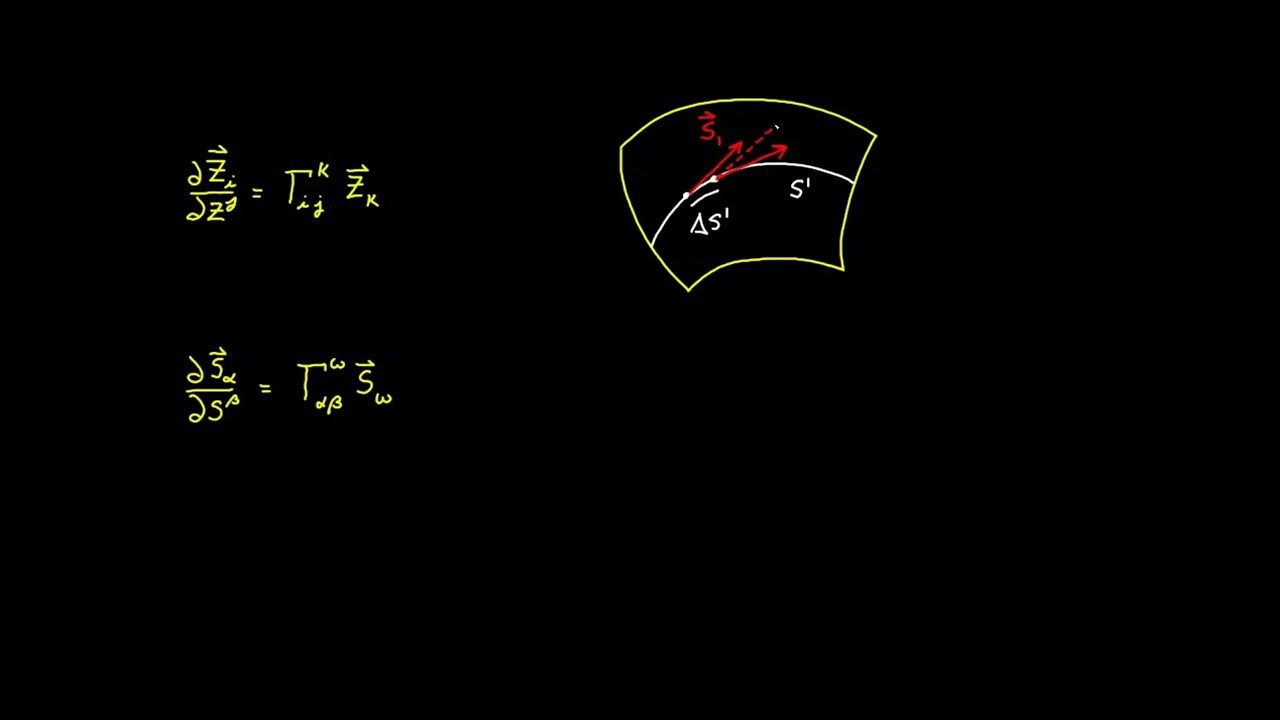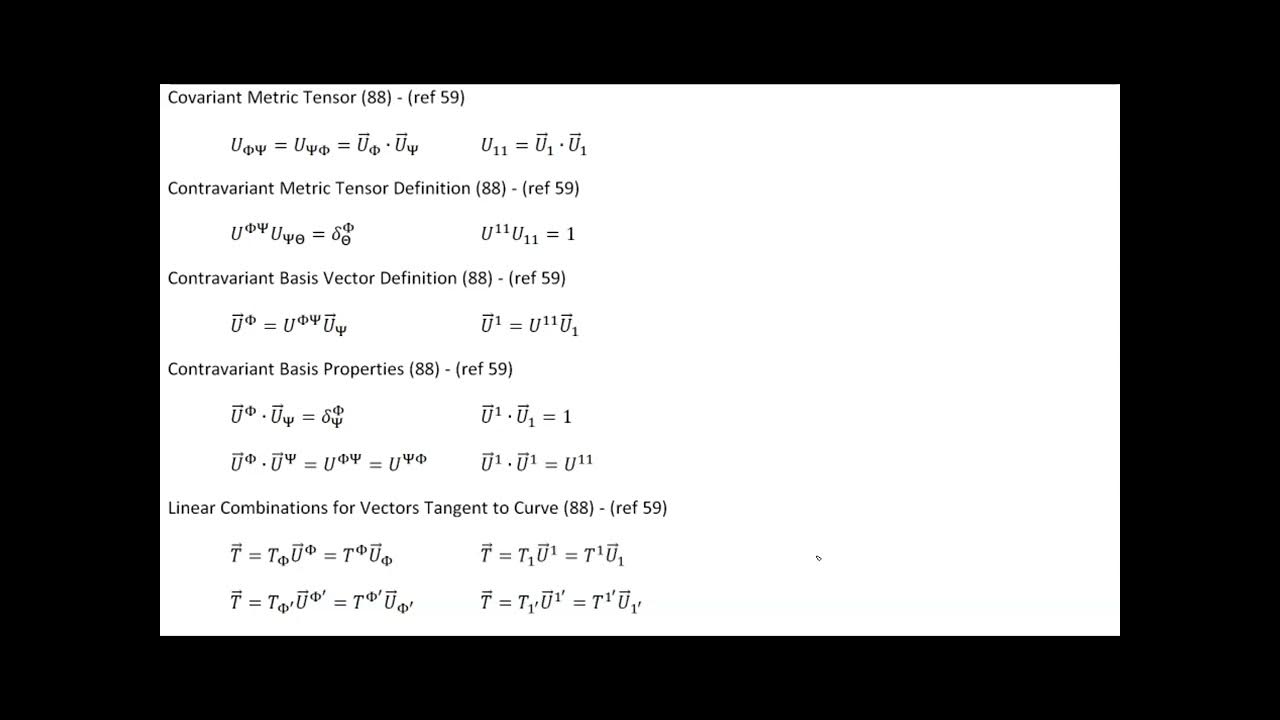Video 69 - Christoffel Symbol for Surfaces - Part 2
TLDRIn this video, the presenter delves into the intricacies of the Christoffel symbol in the context of surfaces and curved manifolds. They explore how the symbol's definition varies with covariant and contravariant bases and the necessity of additional terms for surface manifolds to account for vectors pointing in any direction. The video also demonstrates deriving the proper expression for the Christoffel symbol and shows how to evaluate these symbols for surface manifolds using the ambient coordinates and shift tensor. The special case of affine coordinate systems, where Christoffel symbols are zero, is highlighted, offering a direct method for converting ambient to surface space symbols.
Takeaways
- 📚 The video continues the analysis of the Christoffel symbol in the context of surfaces and curved manifolds, building upon previous discussions.
- 🔍 The Christoffel symbol is introduced with different index positions, highlighting the distinction between covariant and contravariant bases.
- 📉 The script explains that for surface manifolds, an additional term is necessary to account for vectors that may point in any direction, including a normal projection.
- 🔄 Through substitution and application of the product rule, the video derives an expression for the partial derivative of a covariant basis vector in terms of the Christoffel symbol and the metric tensor.
- 📝 The video demonstrates the process of deriving the proper expression for the Christoffel symbol by manipulating and simplifying the given mathematical expressions.
- 🧩 The script shows that the Christoffel symbol can be used for both covariant and contravariant basis vectors with adjustments to the sign and dummy indices.
- ⚖️ The process involves isolating terms and using the properties of the metric tensor and the curvature tensor to simplify the expressions.
- 🔑 The final derived expression for the Christoffel symbol includes both the surface projection using the Christoffel symbol and the normal projection using the curvature tensor.
- 🌐 The video also discusses how to evaluate Christoffel symbols for surface manifolds directly from the ambient space using the shift tensor.
- 🔍 The script concludes with a method to convert Christoffel symbols from an ambient coordinate system to those on a surface manifold using known values and the shift tensor.
- 📚 The video emphasizes the consistency of using the Christoffel symbol and curvature tensor for both surface and normal projections, with adjustments for index positions.
Q & A
What is the main focus of the video 69 on tensor calculus?
-The main focus of the video is to continue the analysis of the Christoffel symbol in relation to surfaces and curved manifolds, and to explore how it can be used to represent expressions involving covariant and contravariant basis vectors.
What is the significance of the difference between covariant and contravariant basis vectors in the context of the Christoffel symbol?
-The difference between covariant and contravariant basis vectors is significant because it affects the sign of the Christoffel symbol and the direction of the indices, which in turn influences how the symbol is used in expressions for surface manifolds.
Why is the expression involving the Christoffel symbol not sufficient for general surface manifolds?
-The expression is not sufficient for general surface manifolds because it may result in a vector that points in any direction, necessitating both a surface projection and a normal projection, which requires an additional term in the expression.
What is the role of the curvature tensor in the context of the Christoffel symbol and surface manifolds?
-The curvature tensor is used in conjunction with the normal basis vector to represent the normal projection of a vector in surface manifolds, which is necessary when dealing with vectors that may point in any direction.
How does the video script derive the proper expression for the Christoffel symbol involving the contravariant basis vector?
-The script derives the proper expression by starting with the partial derivative of the covariant basis vector, making substitutions using the covariant metric tensor, and then simplifying the expression by using the product rule and the properties of the Christoffel symbol and the curvature tensor.
What is the significance of raising and lowering indices in the expressions involving the Christoffel symbol?
-Raising and lowering indices is significant because it changes the position of the indices, which affects the direction of the vectors involved and the resulting expressions, allowing for the correct representation of vectors in different directions.
How does the script show the consistency between the expressions for covariant and contravariant basis vectors?
-The script demonstrates consistency by showing that both cases involve the use of the Christoffel symbol with the surface basis vectors for the surface projection, and the curvature tensor with the normal basis vector for the normal projection, with the only difference being the position of one of the indices.
What is the purpose of contracting both sides of the expression with the contravariant metric tensor?
-Contracting both sides with the contravariant metric tensor is done to isolate specific terms and simplify the expression, ultimately leading to a clearer representation of the partial derivative of the basis vector.
How can the Christoffel symbols for surface manifolds be evaluated directly from the ambient coordinates?
-The Christoffel symbols for surface manifolds can be evaluated directly from the ambient coordinates by using the shift tensor in conjunction with the known Christoffel symbols in the ambient space, as described in the script.
What is the special case mentioned in the script where the second term in the expression for the Christoffel symbol drops out?
-The special case is when the ambient coordinate system is an affine coordinate system, in which all the Christoffel symbols are zero, and only the first term of the expression remains.
Outlines
📚 Introduction to Christoffel Symbols in Surface Manifolds
This paragraph delves into the analysis of Christoffel symbols in relation to surfaces and curved manifolds, building upon previous discussions in videos 28 and 32. The speaker explains the use of Christoffel symbols in different expressions, highlighting the distinction between covariant and contravariant bases. The paragraph emphasizes the necessity of additional terms for surface manifolds to account for vectors that may point in any direction, including both surface projection and normal projection. The focus then shifts to deriving the correct expression for these cases, starting with a substitution involving the covariant metric tensor and the contravariant basis vector, and applying the product rule for differentiation.
🔍 Deriving Expressions for Surface and Normal Projections
The speaker continues the exploration by deriving expressions for surface and normal projections in curved manifolds. They introduce a substitution to express the partial derivative of the covariant basis vector in terms of the Christoffel symbol and the curvature tensor. By manipulating the indices and using the properties of the metric tensor, the paragraph simplifies the expression to isolate the desired term. The process involves canceling out terms and contracting both sides of the equation with the contravariant metric tensor, leading to a final expression that includes the partial derivative of the basis vector, the Christoffel symbol, and the curvature tensor.
📐 Consistency in Surface and Normal Projection Expressions
This section emphasizes the consistency of the derived results for both surface and normal projections. The speaker notes that in both cases, the Christoffel symbol is used in conjunction with the surface basis vectors for the surface projection, and the curvature tensor with the normal basis vector for the normal projection. The difference arises from the position of the index, which dictates whether the projection is surface or normal. The paragraph also discusses the general applicability of the Christoffel symbol and curvature tensor, with the only variation being the index position, and concludes with a method to evaluate Christoffel symbols for surface manifolds directly from the ambient coordinates using the shift tensor.
🔗 Converting Ambient Space Christoffel Symbols to Surface Manifolds
The final paragraph discusses a method to convert Christoffel symbols from the ambient space to the surface manifolds using the shift tensor. The speaker provides a detailed derivation, starting with substitutions for the basis vectors in the surface with their equivalent values using the shift tensor. The process involves applying the product rule and the chain rule for differentiation, leading to an expression that relates the Christoffel symbols in the ambient space to those on the surface. The paragraph concludes by noting that if the ambient coordinate system is affine, the Christoffel symbols are zero, simplifying the conversion process. This method offers a direct way to derive Christoffel symbols for surface manifolds from known values in the ambient coordinate system.
Mindmap
Keywords
💡Christoffel Symbol
💡Covariant Basis
💡Contravariant Basis
💡Surface Manifolds
💡Curvature Tensor
💡Partial Derivative
💡Metric Tensor
💡Shift Tensor
💡Affine Coordinate System
💡Tensor
💡Surface Projection
💡Normal Projection
Highlights
Introduction of the Christoffel symbol in the context of surfaces and curved manifolds, building on previous discussions.
Differentiation between covariant and contravariant basis in the expression of the Christoffel symbol.
The necessity to modify the expression for surface manifolds to include a normal projection term.
Derivation of the proper expression for the Christoffel symbol with a substitution involving the covariant metric tensor.
Use of the product rule to evaluate the partial derivative of the covariant basis vector.
Identification of the partial derivative of the covariant metric tensor as equivalent to the Christoffel symbol.
Isolation of terms to reveal the relationship between the Christoffel symbol and the curvature tensor.
Contraction of both sides of the expression with the contravariant metric tensor to simplify the equation.
Final expression for the partial derivative of the basis vector incorporating the Christoffel symbol and curvature tensor.
Consistency in using the Christoffel symbol for both surface and normal projections in manifolds.
Demonstration of deriving Christoffel symbols for surface manifolds from ambient coordinates using the shift tensor.
Application of the chain rule to express the partial derivative of the basis vector in terms of the shift tensor.
Simplification of the Christoffel symbol expression when the ambient coordinate system is affine.
Direct conversion from ambient space Christoffel symbols to surface space using the shift tensor.
Review of the derived expressions and their application to sample surfaces in upcoming videos.
Transcripts
5.0 / 5 (0 votes)
Thanks for rating:





